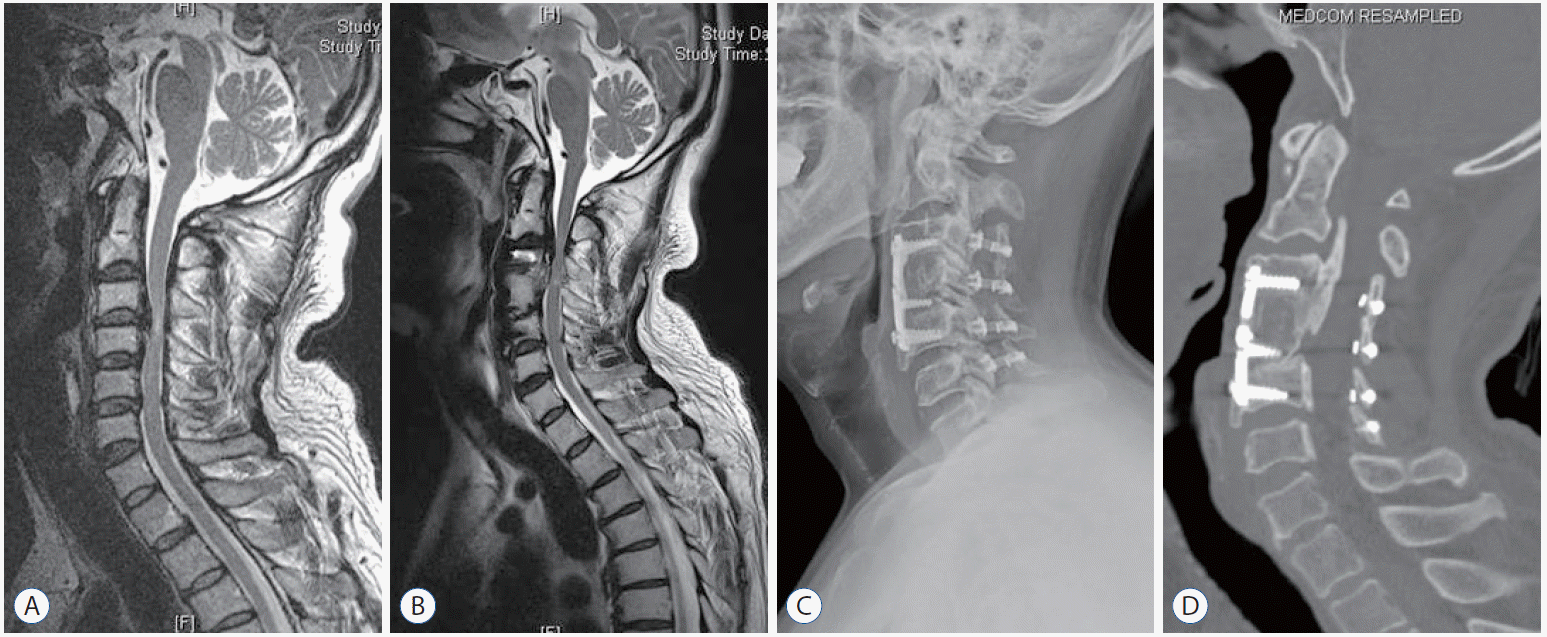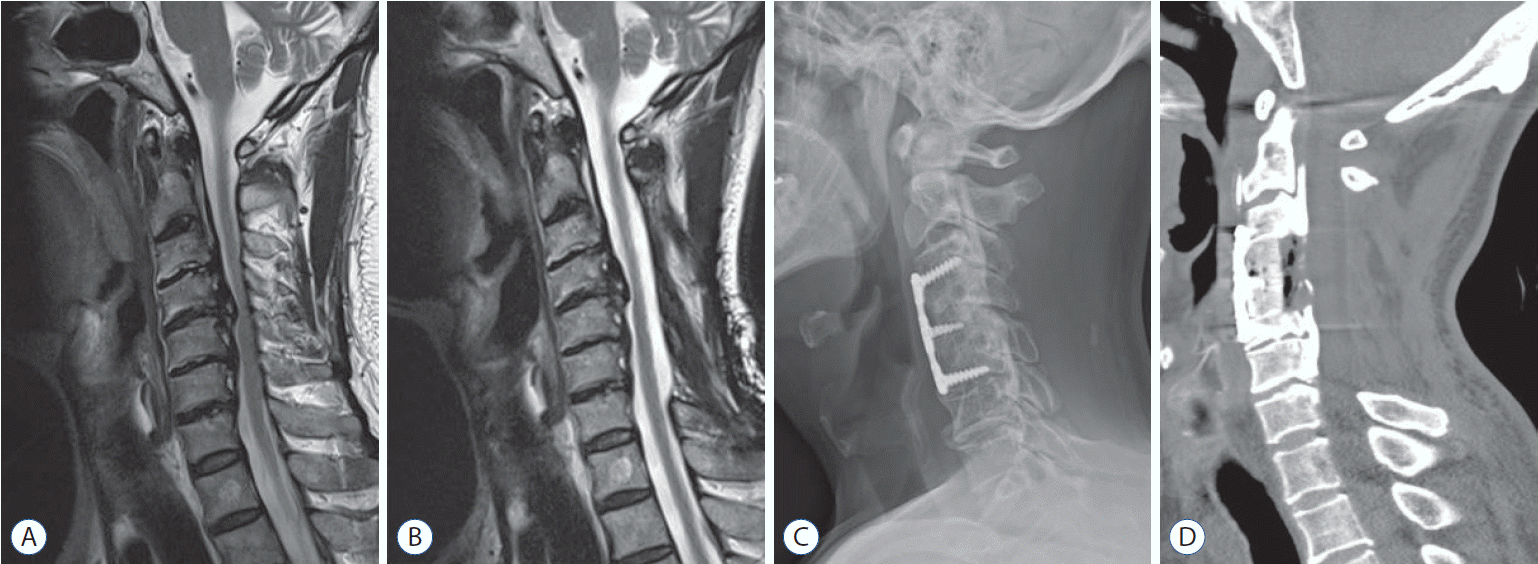Abstract
Objective
Methods
Results
References
Fig. 1

Fig. 2

Fig. 3

Table 1
group AP: patients were approached anteriorly at the initial surgery and underwent posterior approach at the repeat surgery, group PA: patients were approached posteriorly at the initial surgery and underwent anterior approach at the repeat surgery, ACCF: anterior cervical corpectomy and fusion, ACDF: anterior cervical discectomy and fusion
Table 2
| Clinical and radiological characteristics | Group AP (n=10) | Group PA (n=17) |
|---|---|---|
| Age | 61.70±6.18 | 61.00±8.16 |
|
|
||
| Sex (M/F) | 9/1 | 13/4 |
|
|
||
| OPLL type | ||
| Continuous | 2 | 4 |
| Mixed | 6 | 11 |
| Segmental | 2 | 1 |
| Circumscribed | 0 | 1 |
|
|
||
| Interval between the initial and repeat surgeries (months)* | 102.80±60.08 | 61.44±43.04 |
|
|
||
| Change of the main OPLL lesion between surgeries* | ||
| (−) | 2 | 15 |
| (+) | 8 | 2 |
|
|
||
| Occupying ratio on the main OPLL lesion (at the time of repeat surgery) (%) | 52.22±11.51 | 44.67±12.82 |
|
|
||
| Canal anterior-posterior diameter on the main OPLL lesion (at the time of repeat surgery)* (mm) | 10.75±0.79 | 16.27±2.33 |
|
|
||
| Cobb’s angle on C2–7 (at the time of repeat surgery)* (°) | 7.44±5.54 | −3.38±11.08 |
|
|
||
| Segmental angle on the main OPLL lesion (at the time of repeat surgery)* (°) | 2.71±4.24 | −3.52±6.20 |
group AP: patients were approached anteriorly at the initial surgery and underwent posterior approach at the repeat surgery, group PA: patients were approached posteriorly at the initial surgery and underwent anterior approach at the repeat surgery, M: male, F: female, OPLL: ossification of the posterior longitudinal ligament, negative angle: kyphotic curve, positive angle: lordotic curve
Table 3
| Clinical and radiological characteristics | Subgroup LP (laminoplasty) (n=5) | Subgroup LN (laminectomy) (n=11) |
|---|---|---|
| Age | 61.00±3.54 | 62.36±8.77 |
|
|
||
| Sex (M/F) | 4/1 | 8/3 |
|
|
||
| OPLL type | ||
| Continuous | 1 | 3 |
| Mixed | 3 | 7 |
| Segmental | 0 | 1 |
| Circumscribed | 1 | 0 |
|
|
||
| Interval between the initial and repeat surgeries (months) | 56.60±74.61 | 62.64±26.69 |
|
|
||
| Cobb’s angle on C2–7 (at the time of initial surgery) (°) | 4.58±9.29 | 2.96±7.32 |
|
|
||
| Cobb’s angle on C2–7 (at the time of repeat surgery) (°) | −3.32±13.03 | −4.89±9.97 |
|
|
||
| Changes of Cobb’s angle on C2–7 (between initial and repeat surgery) (°) | −7.90±5.61 | −7.86±7.48 |
|
|
||
| Segmental angle on the main OPLL lesion (at the time of initial surgery)* (°) | 3.70±2.80 | −0.10±4.02 |
|
|
||
| Segmental angle on the main OPLL lesion (at the time of repeat surgery) (°) | −1.78±6.79 | −3.85±6.22 |
|
|
||
| Changes of segmental angle on the main OPLL lesion (between initial and repeat surgery) (°) | −5.48±5.69 | −3.74±2.76 |
subgroup LP: patients underwent laminoplasty as a posterior decompression at the initial surgery, subgroup LN: patients underwent laminectomy alone as a posterior decompression at the initial surgery, group PA: patients were approached posteriorly at the initial surgery and underwent anterior approach at the repeat surgery, M: male, F: female, OPLL: ossification of the posterior longitudinal ligament, negative angle: kyphotic curve, positive angle: lordotic curve
Table 4
| Group AP | Group PA | |||
|---|---|---|---|---|
|
|
|
|||
| Preoperative | Postoperative | Preoperative | Postoperative | |
| Nurick scale | ||||
| 0 | 0 | 5 | 0 | 8 |
| 1 | 4 | 2 | 3 | 5 |
| 2 | 1 | 2 | 7 | 3 |
| 3 | 4 | 1 | 4 | 0 |
| 4 | 1 | 0 | 3 | 1 |
| 5 | 0 | 0 | 0 | 0 |
|
|
||||
| Average* | 2.20 | 0.90 | 2.41 | 0.88 |
Nurick scale: 0, signs or symptoms of root involvement but without evidence of spinal cord disease; 1, signs of spinal cord disease but no difficulty in walking; 2, slight difficulty in walking that did not prevent full-time employment; 3, difficulty in walking that prevented full-time employment or the ability to perform all housework but that was not severe enough to require someone else’s help to walk; 4, able to walk with someone else’s help or with the aid of a frame; 5, chairbound or bedridden.




 Citation
Citation Print
Print


 XML Download
XML Download